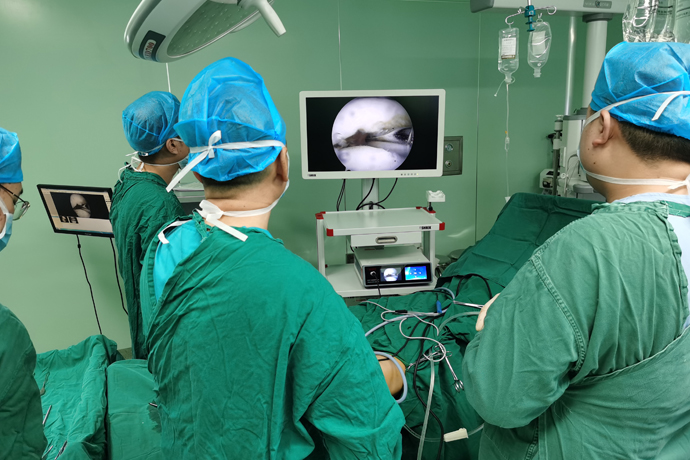[Orthopedic Arthroscopy] Minimally invasive arthroscopic treatment of "popliteal cyst"
Release time: 25 Feb 2025 Author:Shrek
Arthroscopic minimally invasive treatment of "popliteal cyst"
"Popliteal cyst" arthroscopic minimally invasive treatment is in a leading position in the country. Arthroscopic minimally invasive treatment has solved the problem of minimally invasive joint treatment.

Popliteal cyst is the general term for synovial cysts in the popliteal fossa, also called "Baker's cyst", which is a synovial cyst in the medial head of the gastrocnemius muscle. It can be divided into two types: congenital and acquired. The former is more common in children, while the latter can be caused by diseases of the bursa itself, such as chronic injuries. However, some patients are complicated by chronic knee joint lesions. The disease in the elderly is mostly related to knee joint lesions and proliferative arthritis.
The most common popliteal cyst is the distended gastrocnemius and semimembranosus tendon bursa, which often communicates with the posterior joint capsule, resulting in mechanical limitation of knee extension and knee flexion, with mild pain and obvious tension and swelling. The main complaint of patients is often characterized by gradual swelling of the popliteal area, accompanied by pain behind the knee. Occasionally, cysts can compress and block venous return, causing calf edema. Clinically, it is more common in middle-aged and older people, with the highest incidence rate, and is more common in men than women.
Causes of popliteal cyst formation
A correct understanding of the causes of popliteal cysts is very important for how to treat popliteal cysts. Studies have shown that many patients with popliteal cysts are complicated by knee osteoarthritis, meniscal damage, cartilage damage, loose bodies, etc. The lesion causes the opening of the synovial sac of the medial head of the gastrocnemius muscle to become a one-way valve. The synovial fluid can only flow in one direction to the synovial sac and is difficult to flow back. "Only in but not out" causes the synovial sac to accumulate fluid and increase in volume to form a cyst. In fact, up to one in five patients with knee joint disease will develop a popliteal cyst.
Therefore, as long as we try to clear the pathological changes in the knee joint cavity, remove the one-way valve, and open the cyst opening so that the fluid in the cyst can communicate with the joint cavity, the fluid will no longer accumulate in the synovial sac and the cyst will disappear naturally.
Clinical symptoms:
It often manifests as vague pain in the back of the knee, local swelling and mass, and tension in the popliteal area. Some patients, especially children, are often asymptomatic and are only discovered during physical examination.
Traditional surgical treatment:
Popliteal cysts can be treated by traditional incision, but the trauma is large, recovery is slow, and joint function and appearance are seriously affected.
Arthroscopic minimally invasive treatment:
First, it passes through the anterior chamber of the knee joint and enters the posterior compartment of the knee joint through "between the lateral surface of the medial femoral condyle and the posterior cruciate ligament". This process will reveal that many people have lesions on the menisci within their joints, which can be treated together. After entering the posterior compartment of the knee joint, part of the posteromedial joint capsule is first removed.
Then the medial head of the gastrocnemius muscle and the semimembranosus tendon are exposed. This is the internal opening of the cyst. In fact, if it is just for the simple treatment of popliteal cyst, the basic work of exposing this internal opening is completed.
In order to be thorough, we entered the joint cavity. There are still a few "rats" hiding in this cavity and we need to catch them. The mouse was captured so that it would be almost impossible for the cyst to recur.
Arthroscopic minimally invasive treatment is used, with small trauma (1cm small opening) and quick recovery.
Arthroscopic minimally invasive treatment can treat intra-articular lesions, open part of the posterior joint capsule to eliminate the one-way valve function to avoid recurrence, and completely remove the capsule wall.
Advantages of minimally invasive arthroscopic treatment of popliteal cysts
1. While removing the cyst, treat the intra-articular lesions to reduce the recurrence rate at the source.
2. Destroy the one-way valve and reduce the recurrence rate mechanically.
3. Minimally invasive! With several small 5mm incisions, postoperative incision complications are greatly reduced and recovery is quick.
After the operation, the patient reported almost no pain. He was able to walk on the second day and was discharged from the hospital soon after.

- Recommended news
- 【General Surgery Laparoscopy】Cholecystectomy
- Surgery Steps of Hysteroscopy for Intrauterine Adhesion
- 【4K Basics】4K Ultra HD Endoscope Camera System
- 【General Surgery Laparoscopy】"Two-step stratified method" operation flow of left lateral hepatic lobectomy
- 【General Surgery Laparoscopy】Left Hepatectomy